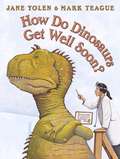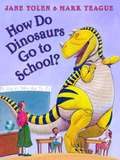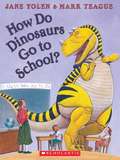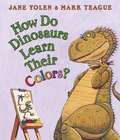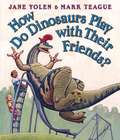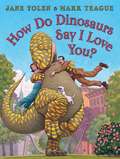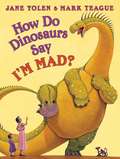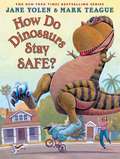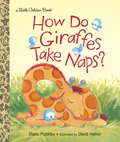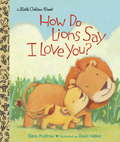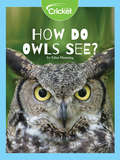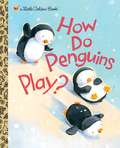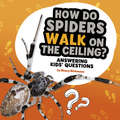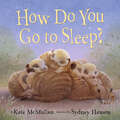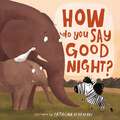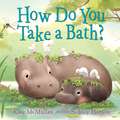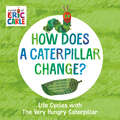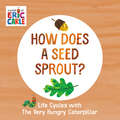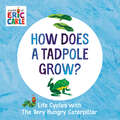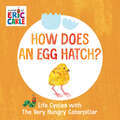- Table View
- List View
How Do Dinosaurs Get Well Soon?
by Jane YolenWhat if a dinosaur catches the flu? Does he whimper and whine between each "At-choo"? Does he drop dirty tissues all over the floor? Does he fling his medicine out of the door? Just like kids, little dinosaurs hate being sick. And going to the doctor can be pretty scary. How DO dinosaurs get well soon? They drink lots of juice, and they get lots of rest; they're good at the doctor's, 'cause doctors know best. From enormous sneezes to gigantic wails, the outrageous antics of the mischievous young dinosaurs in this book are sure to bring laughter to anyone who has ever said "Atchoo!"
How Do Dinosaurs Go to School?
by Jane YolenWhat would you do if a very large ceratosaurus stomped into your classroom? And what if the student sitting next to you was a gigantic silvisaurus -- who decided to jump on top of his desk? Come along for a very unusual day where dinosaur show-and-tell, story time, and recess antics will make even the best-behaved young dinosaurs laugh aloud. School has never been so much fun!
How Do Dinosaurs Go to School? (Elementary Core Reading Ser.)
by Jane Yolen Mark TeagueNIMAC-sourced textbook <P><P>School has never been so much fun! Come along for a very unusual day and laugh out loud as the dinosaurs enjoy story time, show-and-tell and recess.
How Do Dinosaurs Learn Their Colors?
by Jane YolenThe bestselling, award-winning team of Yolen and Teague present their third original dinosaur board book, a fun read-aloud that teaches children all the colors of the rainbow.
How Do Dinosaurs Learn to Read
by Jane YolenAmerica's favorite dinosaurs romp and roar as they soak books in the bathtub, throw them, and finally learn how to carefully read them... with Mama and Papa at bedtime. Get ready to laugh at this lighthearted, heartwarming, and funny approach to books! Children sometimes feel the task of learning to read is overwhelming, but the winning combination of rhyme and illustrations here provide a perfect way to present the subject in a comical, engaging, and nonjudgmental way. The contrast of enormous dinosaurs in kid-sized bedrooms (with human parents) adds irresistible humor as families explore the do's and don'ts of reading. Both practical and engaging, this book shows dinosaurs getting into all sorts of reading-related trouble! But of course, in the end, the dinosaurs learn how to carefully handle their books, read out loud, and read a lot!
How Do Dinosaurs Play with Their Friends?
by Jane Yolen Mark TeagueCome along for some BIG fun as your favorite dinosaurs delight young readers with their playful antics.
How Do Dinosaurs Say Good Night?
by Jane YolenIn each playful spread of this read-aloud bedtime book, parents are ready to put their kids to bed-but these youngsters just happen to be dinosaurs! And though they may stomp and slam their tails a bit, in the end they act a lot like people-they give a big kiss, turn out the light, and whisper "good night".
How Do Dinosaurs Say I Love You?
by Jane YolenHow do dinosaurs say I love you? Little dinosaurs sometimes misbehave or make a mess, but no matter what they do, their mamas and papas always love them. With warmth and irresistible humor, award winners Jane Yolen and Mark Teague present readers with a familiar range of naughty childhood antics followed by dinosaur-sized kisses, hugs, and those three precious words that can never be said too often: I Love You!
How Do Dinosaurs Say Im Mad
by Jane YolenSome of them count to ten, some of them have a time out, and some of them take deep breaths. Then, when the dinosaurs are calm again, they clean up any mess they've made, they say, "I'm sorry," and they give big hugs. Just as you do.
How Do Dinosaurs Stay Safe?
by Jane YolenFrom crossing the street with Mama to encountering a stranger, the playful but careful antics of America's favorite dinosaurs will make readers laugh aloud -- and prompt discussion of safety issues. Few things in childhood are as important as learning how to behave safely, and the topic deserves discussion in every family. Now Jane Yolen and Mark Teague deftly approach this critical subject with warmth, humor, and hilarity. The wildly funny contrast between Teague's massive dinosaur children and their human-sized surroundings makes this subject especially appealing and funny. Where a book about safety for children might be potentially frightening, the antics of immense dinosaurs jumping on the bed or learning how to dial 9-1-1 on Mama's tiny phone will keep readers laughing from start to finish. Parents, children, teachers, and other caregivers need a comfortable way to discuss safety, and this book provides just that. And as children learn invaluable rules about safe behavior, they'll beg to read it again and again for the wildly appealing silliness on each page. Here is a book that belongs in every household!
How Do Flies Walk Upside Down? Questions and Answers About Insects
by Melvin Berger Gilda BergerA series of questions and answers provide information about the physical characteristics, senses, eating habits, life cycles, and behavior of different insects.
How Do Giraffes Take Naps? (Little Golden Book)
by David Walker Diane MuldrowIt's naptime in the animal kingdom, and everyone from puppies to giraffes is curling up to get some rest. Whether it's snoozing under the sea or nesting high in the trees, little ones will enjoy learning about the various ways their favorite animals get their sleep. From the New York Times bestselling author Diane Muldrow (Everything I Need to Know series) and beloved illustrator David Walker (Bears on Chairs).
How Do Lions Say I Love You? (Little Golden Book)
by Diane MuldrowLions say "I love you" with a purr and a cuddle.Wolves say "I love you" with a howl and a huddle.Bears like to say it with a kiss on the muzzle.A mama cow says it with a lick and a nuzzle. . . .Sweet, simple rhymes and glowing illustrations in soft pastels show the touching ways that animals--from elephants to giraffes to chickens--bond with their families.
How Do Owls See?
by Edna ManningOwl eyes function much like human eyes but with some small differences.
How Do Penguins Play? (Little Golden Book)
by David Walker Elizabeth DombeyThis playful rhyming Little Golden Book asks, "How do penguins play?" Children will delight in watching bear cubs, seals, penguins, monkeys, and other animal friends frolicking joyfully with each other. Adorable pastel illustrations show these animals playing king-of-the-hill, keep away, and other fun and familiar games.
How Do Spiders Walk on the Ceiling?: Answering Kids' Questions (Questions and Answers About Animals)
by Nancy DickmannSpiders live everywhere! We even find them inside our homes. But how do they get way up on the ceiling? You have questions, and this book has the answers. Find out about spiders, including their body parts and behavior.
How Do You Go to Sleep?
by Kate McMullanDiscover how different animals go to sleep in this rhyming picture book from a veteran children's author! Follow along as three children learn about the bedtime routines of squirrels, parrots, dolphins, and many more. Meerkats sleep in a stack. Is that how these kids go to sleep? Or do they hibernate in snow all winter long like frogs? Or maybe they sleep the day away like skunks? No, that can't be right! By the book's conclusion, the kids have imitated all kinds of animals who are portrayed sleeping in their natural habitats, thanks to Sydney Hanson's charming illustrations. Readers will recognize the way the human child eventually goes to sleep--with stuffed animals, a bedtime story, and a kiss good night!A Bank Street Best Book of the Year "Punctuated with zaniness, McMullan's litany nevertheless offers a quiet, calming rhythm to help little ones nod off."--Kirkus"A bedtime book that will soothe and please children and caregivers."--SLJ"A nice pairing with Diane Muldrow's How Do Giraffes Take Naps?, Vin Vogel's Bedtime for Yeti, or Cari Best&’s I&’m Brave! I&’m Strong! I&’m Five!, particularly for little ones looking for comfort around sleeping in their own beds."--Booklist
How Do You Lift a Lion?
by Robert E WellsExplore the functions of levers, wheels, and pulleys, and learn how to lift a lion, pull a panda, and deliver a basket of bananas to a baboon birthday party!
How Do You Say Good Night?
by Thomas NelsonA fun, new bedtime story to read to your kids!Join Zoey the zebra as she searches across Africa for the best way to say good night. She sees the bedtime routine of lions, warthogs, monkeys, and more—but which one is the very best?Teaching little ones to celebrate differences while appreciating the blessing of their own unique family, How Do You Say Good Night? is a great way to introduce the concept of diversity in a fun and respectful way while also fostering an attitude of gratitude.Watch your little ones reach for this book night after night!
How Do You Take a Bath?
by Kate McMullanPerfect for fans of Five Little Monkeys Jump in the Bath, this fun and educational picture book brings together adorable baby animals and bathtime.How do YOU take a bath? Does your mama comb your fur?Do you shake off all your dirt?Do you splash and flap and quack?Do the birdies peck your back?No!Follow elephants, pigs, monkeys, hippos, and more in this charming rhyming picture book from veteran author Kate McMullan. How does a pig take a bath? It sinks in the mud! What about a chicken? It thrashes about in dust! And a cat? Why, it licks itself clean, of course! Sydney Hanson's adorable illustrations toggle neatly between animals in nature grooming themselves and humorous depictions of children attempting the animals' bathing tactics. By the end of the book, the child finally makes his way to the bathtub, no mud baths or lick baths about it!
How Does a Caterpillar Change?: Life Cycles with The Very Hungry Caterpillar (The World of Eric Carle)
by Eric CarleLearn how a caterpillar turns into a butterfly with the help of The Very Hungry Caterpillar!In this nonfiction story, young readers can explore the transformation of a caterpillar into a butterfly. The miracles of nature come to life in this early-learning series centered around life cycles, featuring simple text and Eric Carle's classic illustrations!
How Does a Seed Sprout?: Life Cycles with The Very Hungry Caterpillar (The World of Eric Carle)
by Eric CarleLearn how a seed becomes a tree with Eric Carle's classic artwork and The Very Hungry Caterpillar!In this nonfiction story, young readers explore the transformation of a seed into a tree. The miracles of nature come to life in this early-learning series centered around life cycles, featuring simple text and Eric Carle's classic illustrations!
How Does a Tadpole Grow?: Life Cycles with The Very Hungry Caterpillar (The World of Eric Carle)
by Eric CarleLearn how a tadpole becomes a frog with Eric Carle's classic artwork and The Very Hungry Caterpillar!In this nonfiction story, young readers explore the transformation of a tadpole into a frog. The miracles of nature come to life in this early-learning series centered around life cycles, featuring simple text and Eric Carle's classic illustrations!
How Does a Tree Help? (Into Reading, Level B)
by David Bauer<p>NIMAC-sourced textbook <p>All kinds of animals make their homes in trees. Children do, too!</p>
How Does an Egg Hatch?: Life Cycles with The Very Hungry Caterpillar (The World of Eric Carle)
by Eric CarleLearn how an egg becomes a baby chick with Eric Carle's classic artwork!In this nonfiction story, young readers explore the transformation of an egg into a chick. The miracles of nature come to life in this early-learning series centered around life cycles, featuring simple text and Eric Carle's classic illustrations!
